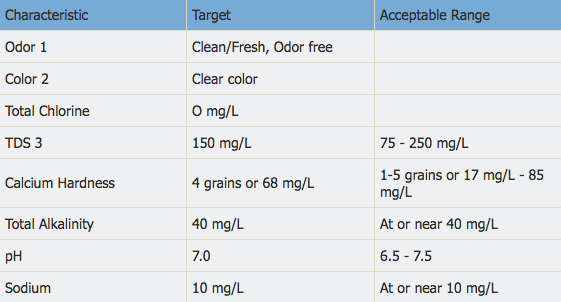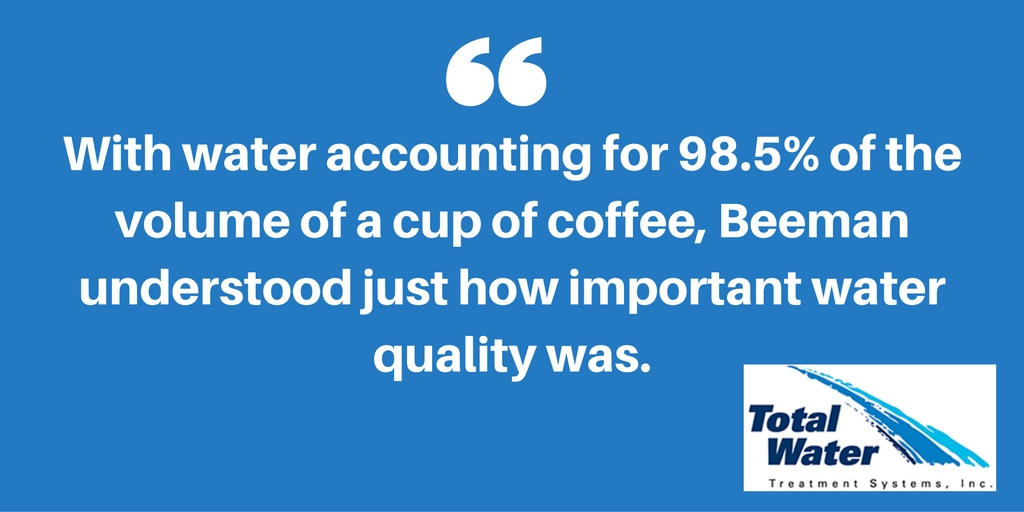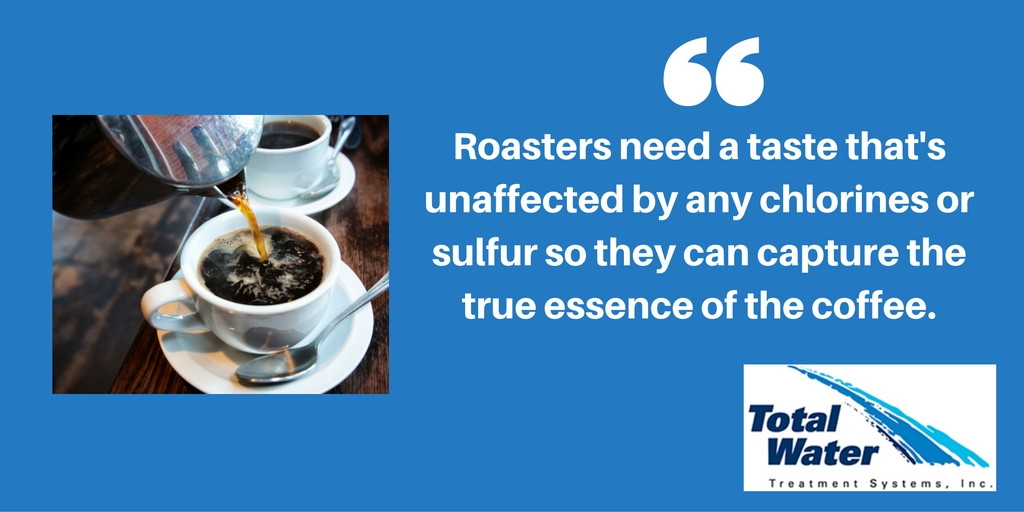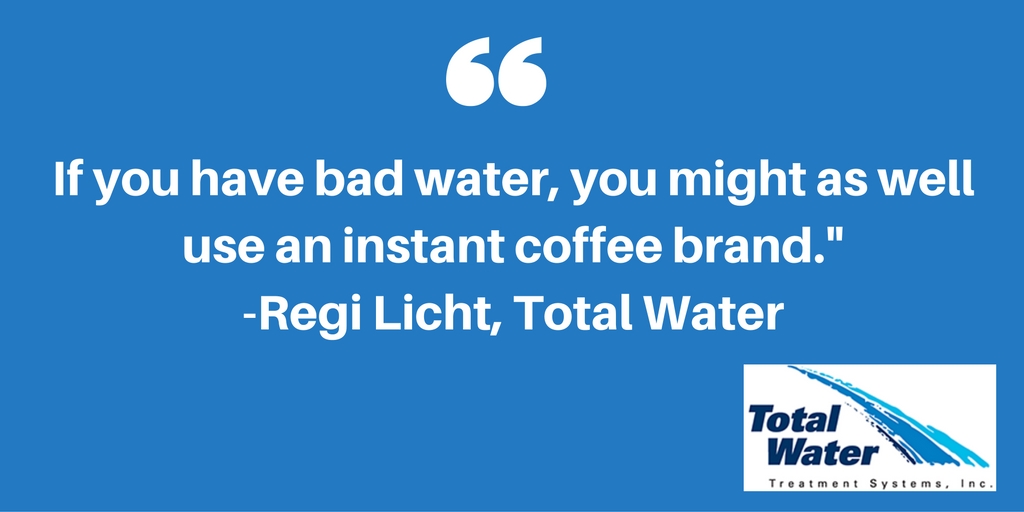Water accounts for 98.5% of the volume in a cup of coffee or tea, a fact largely unknown to those in hot pursuit of great office coffee. Find out why top coffee roasters stress the importance of water quality, and what you can do to make a big difference in your office coffee taste.
When Starbucks opened their first Los Angeles coffeehouse, they discovered their coffee tasted differently. They had been accustomed to coffee in Seattle, where the water had low mineral content. (Santa Monica had a high mineral content in their water.)
They brought in a man named David Beeman for a solution. Beeman brewed two cups of coffee for Starbucks coffee expert Kevin Knox — one with the Santa Monica water, one using customized water.
Knox literally spat out the Santa Monica version. A water standard for coffee was born.
Water: The Critical Ingredient for the Best Office Coffee
With water accounting for 98.5% of the volume of a cup of coffee, Beeman understood just how important the water quality was for the coffee — and he’d proven it to the discerning Knox. Soon he’d crafted a custom water formula that was used in over 7,000 Starbucks.
Beeman went on to write the standard upheld by the Specialty Coffee Association of America (SCAA). These standards are used by coffee roasters as they perfect their particular roast, as it yields the true taste and color of the coffee.
Yet no matter how much roasters focus on water as they produce their coffee, the perfect roast is lost if the water supply in an office or home doesn’t adhere to the same standards. Once you understand the essentials of the water standard, you’ll see why coffee roasters are so adamant about water quality.
Why is Water Quality so Critical for Great Tasting Office Coffee?
Before we get to the standards, you have to understand more about the water itself. Or more accurately, the source of the water.
Municipalities vary widely in how they treat their water. Many use chlorine, sulfur and other disinfectants to purify their water. You notice the treatment when you taste the water; it may have a distinctive, chlorine taste. Or it may have a slight odor — generally from the sulfur.
The appearance can also be affected. Water with higher iron content will yield a reddish color.
All of this has a big impact on roasters who are producing the coffee. When they’re perfecting the roast, they need a taste that’s unaffected by any chlorines or sulfur, so they can capture the true essence of the coffee — similar to what Starbucks experienced in California.
What is the Ideal Water Quality for Coffee?
Regi Licht, Coffee Services Engineer for Total Water, helped us break down the key components of the SCAA Water Standard, which is shown in the chart below.

Odor: Target – Clean/ Fresh, Odor Free
For coffee lovers, there’s nothing quite like the smell of freshly brewed coffee. The aroma is an essential part of the experience, but it is often affected by chlorine and other disinfectants. Iron can also give off a musty odor, and sulfur can produce a rotten egg smell.
Color: Target – Clear Color
Coffee should be brown in appearance, not black. Iron can create a reddish color, and magnesium can cause a black appearance in coffee.
Tannins in water can also influence colors. Tannins come from a variety of sources, such as decaying leaves. It produces a tea color.
Total Chlorine: Target – O mg/L
Chlorine has long been used to oxide bacteria molecules. To stabilize the chlorine molecule, water treatment facilities will add ammonia, which creates a chloramine. Chloramines can stay in a solution longer, providing greater control of bacterial growth both in the facility and the distribution system.
However, chloramines can yield trihalomethanes (THMs), which result when chlorine reacts with naturally occurring organic matter. THMs are toxic compounds that can form as a result of the chlorination in water, and can impart the taste in coffee.
TDS: Target – 150 Mg/L – 250 Mg/L
TDS stands for Total Dissolved Solids. That includes anything that’s in the water other than H20, such as calcium, magnesium, iron, sodium, nitrates and debris.
Sodium can have a big impact in coastal states, or in areas where sodium chloride is used on the streets to control icing. Any of these solids can impact the coffee taste.
Calcium Hardness: Target – 3 grains Calcium
Calcium is important for the proper extraction of flavor from the coffee beans. The water has to “attract” the flavor, and pure H20 won’t cut it. You need a little bit of hardness, otherwise the water will be too pure and won’t attract the flavor.
Regi recommends 3 grains of Calcium – but 1-5 is acceptable. Too much hardness will over extract and cause bitterness.
Total Alkalinity: Target – 40 ppm
Alkalinity refers to the capability of water to neutralize acids. The higher the alkalinity the better the “buffering capacity” in the water.
Too much alkalinity will not allow the water to attract the flavor of the coffee. If the alkalinity is too low, the coffee will attract too much flavor. It will become bitter as a result.
pH: Target – 7.0
pH (which stands for “percent of hydrogen”) is the measure of the acidity or basicity of the solution. Too much acidity and the water becomes too aggressive during the brewing process.
pH simply measures the hydrogen concentration, while the alkalinity measures the ability of the water to buffer acids. One way to think of the difference is the pH is simply a measurement of the current state; the Total Alkalinity indicates what it would take to change the current state.
A low pH indicates the water is on the acidic side, which can lead to corrosion of the internal parts of the coffee equipment. With water, we always want a neutral pH of approximately 7.
Source: http://alkalinewater.vitev.com/health/ph-and-alkalinity-are-not-the-same/
Sodium: Target – Zero
Sodium can cause coffee grounds to swell and expand, which can affect extraction. If the coffee grounds in the filter expand, for example, it’s difficult for water to pass through and extract the flavor.
Swelling masks the grounds. It produces more surface area for the water to cover.
How Does This Relate to Office Coffee?
Roasters want their water to adhere to the standards so they can determine the true taste of their roast. In their roasting labs, they want the water to be consistent and ideal for extracting flavor. The less variables they have to deal with, the more precise their roast can be.
Remember, water comprises 98.5% of your coffee. That’s why coffee aficionados put so much emphasis on the standards.
It’s also the big disconnect for office systems. Touting office coffee as a perk is a welcome benefit. But investing in office coffee without ensuring the water is free of the factors that compromise taste seems like throwing your money to the wind.
“If you have bad water, you might as well use an instant coffee brand,” said Regi.
Not Just About the Office Coffee Maker, Either
Take note that these standards aren’t just related to the office equipment. “You need the water quality first, and you also need consistent pressure, so the amount of the water is consistent,” Regi said.
SCAA’s water standards are established for roasters, but they don’t certify water systems. To Regi, this is where the disconnect occurs. “We find some of the manufacturers or providers of the water treatment systems don’t even know the standards,” he said.
That’s unfortunate, because not only does adhering the standard improve the taste, it lengthens the lifespan of the equipment.
For example, lime (calcium) and water hardness in general leave deposits in the equipment and plug small lines. Lime Out or other acids are needed to remove these deposits. This treatment can be hard on the metals within the equipment and cause early failures. Heating elements also scale up and have to be replaced.
Typical deliming of an espresso machine averages around $650.00, plus any repair needed. (The price of pure water treatment is significantly less and pays for itself in comparison to the costs of removing the deposits.)
If you’re truly committed to delivering quality office coffee for your staff, then it’s time to focus on 98.5% of what goes into every cup. Use the proper water filtration system to adhere to the standards above, and you’ll truly taste the coffee that roasters have worked so diligently to create.
We’ll do more than give you a quote—we’ll visit your site to analyze your industrial water needs.





Follow Us